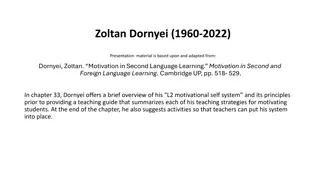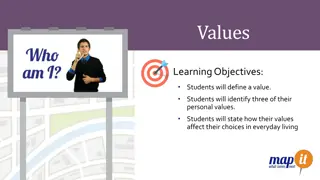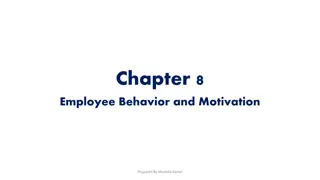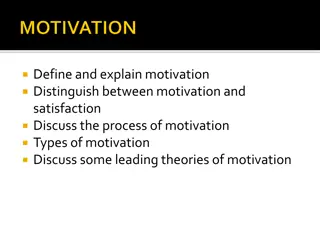Personal Values and Motivation
Personal values form the foundation of goal setting and motivation. Values, our core principles, guide our decisions and actions. By clarifying our values and aligning them with our daily actions and career choices, we can enhance our intrinsic motivation for sustainable growth and success in academics and beyond.
Download Presentation

Please find below an Image/Link to download the presentation.
The content on the website is provided AS IS for your information and personal use only. It may not be sold, licensed, or shared on other websites without obtaining consent from the author.If you encounter any issues during the download, it is possible that the publisher has removed the file from their server.
You are allowed to download the files provided on this website for personal or commercial use, subject to the condition that they are used lawfully. All files are the property of their respective owners.
The content on the website is provided AS IS for your information and personal use only. It may not be sold, licensed, or shared on other websites without obtaining consent from the author.
E N D
Presentation Transcript
Personal Values Goal setting and motivation are based on PERSONAL VALUES Values are what we think is important Can be thought of as principles or beliefs We use values to make judgements and decisions Values explain why we do the things we do
Values Clarification 1. Review the list of 90 values 2. Go through and circle any values that are very important to you (Not all values are listed, feel free to add your own) 3. Go back through and narrow down your circled values to 5 4. Rank your top 5 values at the bottom of the sheet
Values in Action Do you see your values demonstrated in day-to-day actions? Ex: You value health and spend time meal prepping and working out Are your values in line with your major or career choice? Ex: You value justice and would like to go to law school
Motivation Values inform your motivations MOTIVATIONS can be intrinsic or extrinsic INTRINSIC comes from within, can be characterized as inspiration Pride, sense of progress, desire to learn, achievement, curiosity, etc. EXTRINSIC comes from others (reward or punishment), can be characterized as manipulation Grades, scholarships, Aggie Ring, academic probation
Motivation Intrinsic is more sustainable than extrinsic Fear is a motivator BUT it is not healthy, especially over sustained time Why don t you quit?
Motivation in Academics Where motivation shows up in academics: Choices What do you choose to do? Do you attend class regularly, or skip? Initiation How fast do you get started on homework, assignments, and studying? Intensity How hard do you try? Do you actively engage in lecture or just go through the motions of taking notes? Persistence How long do you try? Do you give up when it gets difficult or are you determined to understand and keep going? Thoughts/feelings What do you think while you are studying? Are you confident you can do well or do you worry about failing? Adapted from Sellers, Dochen, and Hodges (2015). Academic transformation: The road to college success. p. 130
Goal Setting Values explain why you want to accomplish something Goal explain what you want to accomplish and how you will do it Outcome goals (long-range) Process goals (intermediate) Actions & tasks
SMART Goals Specific describe what you want to accomplish with as much detail as possible Measurable describes your goal in terms that can be clearly evaluated Action-Oriented identifies a goal that focuses on actions rather than personal qualities Realistic identifies a goal you know you are actually capable of attaining Timely clearly specifies a completion date
Examples of SMART goals Outcome (long-range) goals: I want to take an advanced mathematics course next semester. I want to attain a 3.0 GPA this semester. I want to complete my research papers 1 week before handing them in so I have time to edit them.
Examples, cont. Break down outcome goal into smaller process (intermediate) goals. How will you accomplish the big goal? For the goal I want to attain a 3.0 GPA this semester. Process goals: I will attend all class meetings this semester. I will study at least 30 hours per week. I will begin homework within 2 days of being assigned.
Examples, cont. Break down each process goal into actions and tasks These actions help you accomplish the process goal For the process goal I will attend all class meetings this semester. Actions and Tasks: Get an accountability partner in each class. Agree to pay $ if I don t come. Move my alarm across the room/use an alarm app to make sure I get up. Pack my lunch the night before so I won t go home during the day.
Goal Mapping Activity Set your own goals using the Goal Mapping worksheet. Create an academic goal for this semester. 1. Begin with your long-range outcome goal. What do you want to accomplish? Make sure it is SMART! 2. Break down the outcome goal into three intermediate process goals. These explain how you will do it. 3. Break down each process goal into actions and tasks. 4. Answer the questions related to your goals. *Write with the expectation that someone else will read it. You will swap with a neighbor.*























